Ski report from Kebnekaise, April 2001.
Ice climbing, snow caves, skiing powder in Tuolpagorni's bowl.
If you want the background to these stories, see the introduction.
March 29, 2001, and the start of my fifth ski tour in Lappland. Spring had come
to Uppsala with a vengence - a week of windless, cloudless days with
temperatures above zero had cleared all the snow, and put me more in the mood
for rock climbing than skiing. But just an hour north the train passed a
weather boundary and we were back in winter with a foot of snow on the ground.
I was more nervous than usual because I was planning to be pushing boundaries
this time - staying in a snow cave and doing technical summit attempts,
rather than my usual routine cabin ski tour, and I would for the first time
not be alone, but would be sharing the adventure with Mad Al, whose mind and
body know no limits.
But I soon got into the routine - struggle with Tågkompaniet's ineptitude
to get to my compartment that will either be double booked or locked or both,
go off to the buffé car to consume an individual bottle of wine and
a meal of reindeer shavings, and mellow out as the fairy-tale landscape
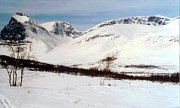
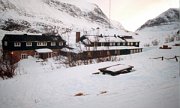 outside slowly fades to black. Then watch a depressing Swedish film in the
travelling cinema, before trying to sleep as the train bumps and hoots its way
through the night. Almost no-one lives in Sweden, so the chances of knowing someone
you meet on a train is high. This time it was Andreas, a climber whom
I'd met previously at the crags, and who at midnight I discovered was
sharing my compartment.
I picked his brains mercilessly into the night until he had none left, but I had
accumulated a lot of useful information about climbing around Kebnekaise.
outside slowly fades to black. Then watch a depressing Swedish film in the
travelling cinema, before trying to sleep as the train bumps and hoots its way
through the night. Almost no-one lives in Sweden, so the chances of knowing someone
you meet on a train is high. This time it was Andreas, a climber whom
I'd met previously at the crags, and who at midnight I discovered was
sharing my compartment.
I picked his brains mercilessly into the night until he had none left, but I had
accumulated a lot of useful information about climbing around Kebnekaise.
The weather was still great when we arrived in Kiruna, but I was surprised
that there was no more snow there than 12 hours south. From Kiruna it is
a one-hour bus ride west to Nikkaluokta, and then 4 to 5 hours skiing
or an hour by snow-scooter taxi (Görans Fjälltransport, 0980-54000)
to the Fjällstation. I as usual opted for the scooter, so that I could
enjoy the day skiing unencumbered in the real mountains rather than slogging
through the valley with 30 kg of luggage, but the purist in me always feels
bad about it. A compromise is to send your pack with the scooter and ski in
with minimal equipment.
In the fjällstation shop I bought some of the heavier food items that
I hadn't wanted to carry up from Uppsala, and also tried to buy petrol for
my MSR stove, but surprisingly they don't stock it. But ever accomodating,
they took me down to the basement and syphoned half a litre out of a snow mobile.

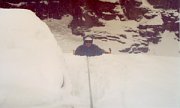 The next day I got up early and took a quick trip up on to Tarfalatjärro, which
is an easy way to see across to the high peaks and glaciers further north,
and I did this shirtless because it was so warm and the sun so intense.
Only when I lost my balance into a snow drift was I rapidly reminded
that it was still winter.
I was using for the first time my Åsnes Nansen skis, which are supposed to be a good compromise
between touring and downhill performance, but I found them to be bad at both, and regretted having
opted to lend my Tua Cirques to Al. They are great downhill, and the Nansens were not much
better on the flat. I also regretted giving in and lending Al my climbing skins, which would have
helped a lot.
Al arrived by scooter taxi in the afternoon, and because of the
fantastic weather we decided to go for our summit attempt the next day, before it broke.
So the rest of the day I spent resting and eating in anticipation. Which of course
meant that we woke to low cloud and snowfall, not good conditions to attempt
the ambitious (for us) east route, and my idle day had been wasted.
The next day I got up early and took a quick trip up on to Tarfalatjärro, which
is an easy way to see across to the high peaks and glaciers further north,
and I did this shirtless because it was so warm and the sun so intense.
Only when I lost my balance into a snow drift was I rapidly reminded
that it was still winter.
I was using for the first time my Åsnes Nansen skis, which are supposed to be a good compromise
between touring and downhill performance, but I found them to be bad at both, and regretted having
opted to lend my Tua Cirques to Al. They are great downhill, and the Nansens were not much
better on the flat. I also regretted giving in and lending Al my climbing skins, which would have
helped a lot.
Al arrived by scooter taxi in the afternoon, and because of the
fantastic weather we decided to go for our summit attempt the next day, before it broke.
So the rest of the day I spent resting and eating in anticipation. Which of course
meant that we woke to low cloud and snowfall, not good conditions to attempt
the ambitious (for us) east route, and my idle day had been wasted.
To make up for this disappointment, we went ice climbing in a ravine running down from
Skarttatjåkka,
where runoff forms 15m high walls of ice for a distance of about 50m.
It would be a bit tame for experienced ice climbers, but being used to a wall
5m high by 2m wide in Uppsala, we were delighted.
We found that the fjällstation doesn't normally rent out technical axes,
but we were lucky that they happened to have some demo models on loan
that we were allowed to use. (Generally you must bring your own or go on a guided trip).
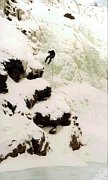
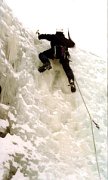 Thus armed, we skied about 3 km down Ladtjovagge and across the river
to the ravine (SG E1620350 N7531405) and warmed up bouldering on the low-angle
ice lower down, before attempting our first leads on the taller, steeper ice higher up the ravine. There are trees above the ice that can be hiked to if
you prefer to top rope, so the area is very good for beginners. We had so much
fun that it was 9pm by the time we got home to sauna and eat.
Thus armed, we skied about 3 km down Ladtjovagge and across the river
to the ravine (SG E1620350 N7531405) and warmed up bouldering on the low-angle
ice lower down, before attempting our first leads on the taller, steeper ice higher up the ravine. There are trees above the ice that can be hiked to if
you prefer to top rope, so the area is very good for beginners. We had so much
fun that it was 9pm by the time we got home to sauna and eat.
It was still snowing the next morning, and rather than hope for clear weather
anytime soon, we decided to move on to the cabin at Singi, whence we could take the
easy Durling's route to the south top in pretty much any weather. This great plan
foundered in the deep wet snow as the icing up of Al's climbing skins and my
sinking, rolling sled kept us to about 2 km/hr, meaning that "popping to
the next cabin" would involve a 6 or 7 hour slog in each direction, which didn't
seem like a great way to spend our holiday. To cut our losses for the day,
we turned back, headed for Tarfaladalen, and built ourselves a snow cave to spend the night in.
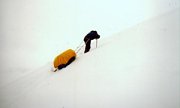
 We chose to build our cave in a drift near the bridge (SG E1619532 N7533455),
which was safe from the avalanches that are common 100m further up the valley,
and started digging. After an hour we had a small cat hole that would have done
in an emergency, but what we had in mind was more palatial, so we kept digging
for another 4 hours until we had two large alcoves for our bedrooms and
a dining area in between. The books all say that you should work slowly to avoid sweating,
but that seems all but impossible, so I wore just thin underwear under my shell,
and worked fast, with the intention of sacrificing those clothes to the inevitable
freezing when I changed them for a dry set later. We also smoothed the ceiling
carefully to avoid drips, and made channels around the side of the bed to direct
water away, but our cave never got that damp, perhaps because we could afford to have
a wide doorway because of its length and the mild weather outside. We also made
1cm wide vents with a ski pole through the ceiling (which was between 20cm and 150cm thick),
and I thought
We chose to build our cave in a drift near the bridge (SG E1619532 N7533455),
which was safe from the avalanches that are common 100m further up the valley,
and started digging. After an hour we had a small cat hole that would have done
in an emergency, but what we had in mind was more palatial, so we kept digging
for another 4 hours until we had two large alcoves for our bedrooms and
a dining area in between. The books all say that you should work slowly to avoid sweating,
but that seems all but impossible, so I wore just thin underwear under my shell,
and worked fast, with the intention of sacrificing those clothes to the inevitable
freezing when I changed them for a dry set later. We also smoothed the ceiling
carefully to avoid drips, and made channels around the side of the bed to direct
water away, but our cave never got that damp, perhaps because we could afford to have
a wide doorway because of its length and the mild weather outside. We also made
1cm wide vents with a ski pole through the ceiling (which was between 20cm and 150cm thick),
and I thought
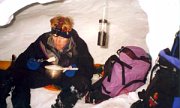
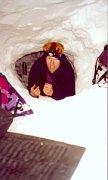 that having one above the head of my bed was a good idea, until I realised
that my sleeping bag was slowly filling with spin drift that was finding its
way down the tiny sloping channel.
It was very light inside during the day, even though we couldn't see directly outside,
and when it got dark we suspended a lantern from an ice screw in the ceiling.
The last weather observation outside was -7°C and 5 m/s, but it most likely
dipped below -10°C during the night, whereas indoors it was always between
zero and +4°C, quiet and draft free. Things might have changed early in the evening when
Sara from the fjällstation inadvertantly skied over the cornice above us, but sadly she didn't drop into our home.
that having one above the head of my bed was a good idea, until I realised
that my sleeping bag was slowly filling with spin drift that was finding its
way down the tiny sloping channel.
It was very light inside during the day, even though we couldn't see directly outside,
and when it got dark we suspended a lantern from an ice screw in the ceiling.
The last weather observation outside was -7°C and 5 m/s, but it most likely
dipped below -10°C during the night, whereas indoors it was always between
zero and +4°C, quiet and draft free. Things might have changed early in the evening when
Sara from the fjällstation inadvertantly skied over the cornice above us, but sadly she didn't drop into our home.
At bedtime Al pursuaded me as usual that he needed my gear more than I did, so I gave him my
wind sack that I was planning to sleep in. I was left with an emergency space blanket,
which resulted in minimal friction between my sleeping pads and the floor, and their subsequent
disapperance every time I moved during the night.
So I was quite happy when Al wanted to move back to the fjällstation the following night,
although otherwise the cave was surprisingly comfortable and dry.
For a good introduction to building your own snow cave, see : http://www.etisurvival.com/snocv.htm
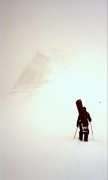
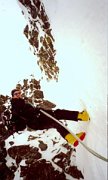 It continued to snow, but now a beautiful light powder, so the next day we set
out to fulfill another goal - to ski the bowl of Tuolpagorni. This mountain
is actually the one the local Sami mean when they say Kebnekaise,
which means "the steep mountain with the casserole on top" in their language,
and it is much more noticeable and dramatic than Sweden's highest point
that is now known as Kebnekaise. The casserole, which was formed by a hanging
glacier, is about 500m across and stays snow-filled all year round.
You need a rope to rappel into the top of the bowl, but after that you
have a vertical kilometer of skiing back down to the fjällstation.
And today that would be a vertical kilometer of knee-deep powder...
It continued to snow, but now a beautiful light powder, so the next day we set
out to fulfill another goal - to ski the bowl of Tuolpagorni. This mountain
is actually the one the local Sami mean when they say Kebnekaise,
which means "the steep mountain with the casserole on top" in their language,
and it is much more noticeable and dramatic than Sweden's highest point
that is now known as Kebnekaise. The casserole, which was formed by a hanging
glacier, is about 500m across and stays snow-filled all year round.
You need a rope to rappel into the top of the bowl, but after that you
have a vertical kilometer of skiing back down to the fjällstation.
And today that would be a vertical kilometer of knee-deep powder...
Al rented snowshoes and a snowboard, while I chose randonée skis,
and we set off alone, feeling the flip-side of the beautiful snow as
we broke trail all the way. It took two hours to reach Kitteldalen, twice as long as usual,
and we were struggling already.
Al had trouble traversing, and I had trouble with the steeps, both from backsliding
and from the weight of my pack when I had the rope.
It took another hour to ascend Kitteldalen, and we lunched under Björling's glacier.
It was -12°C and blowing maybe 3-4 m/s, so we were freezing when we set off up
the saddle between Tuolpagorni and Vierranvarri. This section is always a nightmare,
as it is too steep to ascend directly, and zig-zagging on long traverses seems
interminable, especially for Al on his snowshoes. We finally reached the top
of Tuolpagorni after struggling for a total of 7 hours, and located the fixed rappel
anchor in the couloir (SG E1614037 N7533633).
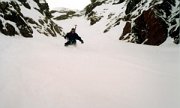
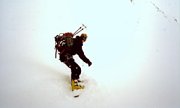 It should have been a jubilant moment, but we had given everything we had to get up here,
and it wasn't clear that we had the strength to get down in the style deserved
by 1000m of untracked powder. I rappelled first, down the steep
but not vertical rock, and on to the 60° snow slope. At the end of our 25m
doubled rappel line the couloir was still too narrow for me to consider skiing,
so I hiked down another 25m and Al lowered my skis with the full length of the rope.
I anchored myself on my axe and was stripping the skins from my skis while
waiting for Al to join me when he started slipping and crashed into me at some speed.
Luckily the axe held, and the tradgedy of losing more powder-metres was averted.
The slope of the bowl slowly levels off to almost nothing at the obvious
exit point at the bottom. It was certainly a great experience to ski across it,
and the weather even brightened enough for us to read the snow, so despite our
exhaustion we got down with some remnants of style.
It should have been a jubilant moment, but we had given everything we had to get up here,
and it wasn't clear that we had the strength to get down in the style deserved
by 1000m of untracked powder. I rappelled first, down the steep
but not vertical rock, and on to the 60° snow slope. At the end of our 25m
doubled rappel line the couloir was still too narrow for me to consider skiing,
so I hiked down another 25m and Al lowered my skis with the full length of the rope.
I anchored myself on my axe and was stripping the skins from my skis while
waiting for Al to join me when he started slipping and crashed into me at some speed.
Luckily the axe held, and the tradgedy of losing more powder-metres was averted.
The slope of the bowl slowly levels off to almost nothing at the obvious
exit point at the bottom. It was certainly a great experience to ski across it,
and the weather even brightened enough for us to read the snow, so despite our
exhaustion we got down with some remnants of style.
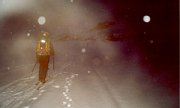
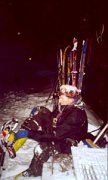 The exit chute starts rocky and steep, so I belayed Al down the first few metres,
but it soon became clear that a rope was unneccesary. Al boarded most of the
chute because the dude is somewhat gnarly and rad,
but again I waited until it widened, because I'm a wimp. The chute opens
into a wide snow field that I was just beginning to enjoy when we realised
that we were off route, and too far to our right. There were several lines that looked skiable
as far as we could see, but the flat and fading light made it hard to judge,
and I was particularly worried that we would ski down 200m and find ourselves
above an impassable cliff, with little hope of ascending again up so steep a slope. We played safe and lost an hour struggling up maybe 30 vertical meters
to get back to the gentle rock-free line that lead to the top of Kitteldalen,
where we could again have some fun. (We later learned that going right would have been just fine.)
By the time we reached the bottom it was almost dark,
and we drank the last of our hot water before plodding home by headlamp.
We arrived at 9:30pm, exactly 12 hours after we left,
covered in snow and ice from head to toe, and still wearing our frozen harnesses.
The exit chute starts rocky and steep, so I belayed Al down the first few metres,
but it soon became clear that a rope was unneccesary. Al boarded most of the
chute because the dude is somewhat gnarly and rad,
but again I waited until it widened, because I'm a wimp. The chute opens
into a wide snow field that I was just beginning to enjoy when we realised
that we were off route, and too far to our right. There were several lines that looked skiable
as far as we could see, but the flat and fading light made it hard to judge,
and I was particularly worried that we would ski down 200m and find ourselves
above an impassable cliff, with little hope of ascending again up so steep a slope. We played safe and lost an hour struggling up maybe 30 vertical meters
to get back to the gentle rock-free line that lead to the top of Kitteldalen,
where we could again have some fun. (We later learned that going right would have been just fine.)
By the time we reached the bottom it was almost dark,
and we drank the last of our hot water before plodding home by headlamp.
We arrived at 9:30pm, exactly 12 hours after we left,
covered in snow and ice from head to toe, and still wearing our frozen harnesses.
We had rented our equipment for two days in the expectation of making a final
attempt on the south top the second day,
but the impossibility of that happening had dawned on us quite early.
It was all we could do to plod up Personalbacken a couple of times
(about 500m of elevation) and do the neat turns that had eluded me the day before.
The next day I took the scooter back to Nikkaluokta. The passengers sat in one trailer, with our luggage
in another trailer behind, and as we pulled away Göran told us that people called our driver
Tommi Mäkkinen, and that we would find out why. He certainly drove with the speed of Mäkkinen,
but not the skill, and he rolled the second trailer three times during the trip, crushing my skis on the last roll.
I was looking forward to some nice new skis, but Göran didn't have insurance for such, so we eventually agreed
that he would give me in compensation a pair of ex-rentals that were older but a much better model.
That seemed like a deal considering I didn't like the Nansens anyway.
Al had to return to Uppsala, but I had an extra day before my train south, which I spent alpine skiing
at Riksgränsen, and finally found out why this place is so famous.
It's definitely a neat place to ski, and essentially consists of a handful of lifts
from which you can create your own runs by skiing wherever you like over the mountain,
but unlike the other off-piste facility up there (Njulla in Abisko),
there isn't much danger of finding yourself trapped above a nasty cliff
(although I did manage to do just that on my last run...).
There are a few prepared pistes if you like that sort of thing, and even on a
beautiful sunny Saturday in April, it wasn't at all crowded.
I went straight from the piste to the train, and luxuriated in the shower before spending the evening chatting
with a nice couple of guys who were returning from similar adventures, and who had been wearing their
clothes for a similar number of days. We didn't notice anything, but a guy from some way down the corridor
came along and very politely asked if we keep our door shut because of the "strange smell that seemed
to be coming from our compartment".
So, this trip was a bit less coherent than usual, but fun, and a good learning experience,
using mountaineering skills that I had only read about previously.
Definitely a success.
I have now failed to climb Kebnekaise four times, and I think that if I manage
one more time I should be eligible for a merit badge, perhaps with a little
broken ice axe on it.
© Mark Harris 2001
(Back to ski report index)
(MRH homepage)

 outside slowly fades to black. Then watch a depressing Swedish film in the
travelling cinema, before trying to sleep as the train bumps and hoots its way
through the night. Almost no-one lives in Sweden, so the chances of knowing someone
you meet on a train is high. This time it was Andreas, a climber whom
I'd met previously at the crags, and who at midnight I discovered was
sharing my compartment.
I picked his brains mercilessly into the night until he had none left, but I had
accumulated a lot of useful information about climbing around Kebnekaise.
outside slowly fades to black. Then watch a depressing Swedish film in the
travelling cinema, before trying to sleep as the train bumps and hoots its way
through the night. Almost no-one lives in Sweden, so the chances of knowing someone
you meet on a train is high. This time it was Andreas, a climber whom
I'd met previously at the crags, and who at midnight I discovered was
sharing my compartment.
I picked his brains mercilessly into the night until he had none left, but I had
accumulated a lot of useful information about climbing around Kebnekaise.













